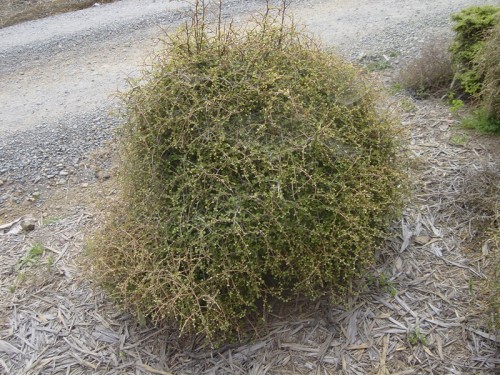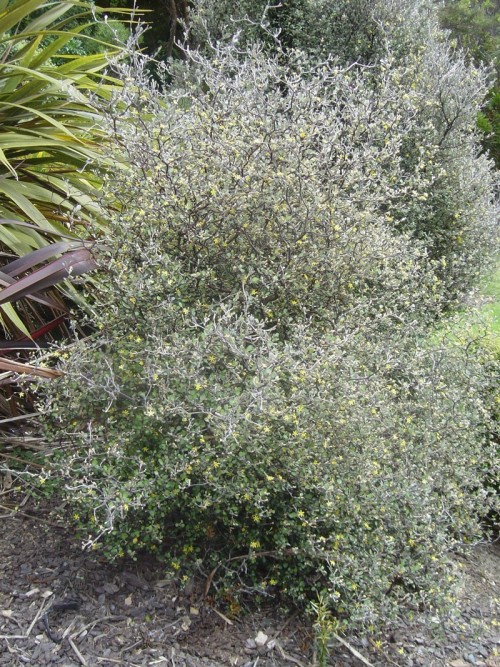Nurseryman Guy Bowden explains why certain overlooked plants deserve a place in the Kiwi garden
Our native vegetation has so many striking features like the Kauri forests of the north, subtropical rainforests of the west coast of the South Island, an abundance of ferns, vast areas of tussocks in central Otago, and cabbage trees standing out in pasture lands.
One New Zealand phenomenon that is not immediately obvious and often overlooked is the abundance of small-leaved, twiggy shrubs, or 'stuff going everywhere' type plants, as a person who worked for me once described them. These shrubs are known as divaricating, which means branches at a wide angle up to 90 degrees or more.
In other shrubs or trees there is a leading shoot at the apex with side shoots below dictating the upright form of the plant. In contrast divaricating shrubs consist of masses of tangled criss-crossed branches bearing tiny leaves with no dominating influence of a leading shoot.
This can result in springy ball-like shrubs forming dense hummocks, so dense that in some situations you can jump into them without breaking through the surface.

Divaricating shrubs can be found in many different situations, including wet lands, salt marshes, and under forests trees, but you will find the greatest number on the dry eastern side of the country – Canterbury being the world headquarters for this uniquely New Zealand phenomenon.
When I first became interested in these plants they all looked the same and the easiest solution seemed to be to call them all Coprosmas.
About 60 New Zealand species could be classed as divaricating, covering many genera. Some species differ so much it is hard to believe they are related.
Even more bizarre are plants that begin life as small-leaved, tangled divaricating shrubs (juvenile stages) that grow into normal leafy trees. Perhaps the most striking example of this is Pseudopanax crassifolius or lancewood; in its juvenile stage it has tough strap-like leaves, then as an adult the leaves become broader, more upright and soft.
Botanists have put forward two main suggestions as to why so many New Zealand plants that are unrelated have evolved with small leaves in an interlacing form. One thought sees it as a defensive mechanism against browsing by large flightless birds like Moas. The other line of thought is climatic.
The Moa browsing theory is based around small-leaved, tangle-branched shrubs appearing as unappetising. Tough, springy twigs and branches form a protective layer around the leaves, flowers and fruit of these plants. The plants with divaricating juvenile stages that change once they are larger do so only when large enough to be out of reach of browsing Moas.
Doubt has been cast on these assumptions because plant material found in fossilised Moa gizzards consisted of twigs, some of which were divaricating species and part of their normal diet. Personally, I think the Moa theory has a nice ring to it and merits serious consideration.
The climatic theory on why we have so many divaricating shrubs is based on an evolutionary response to environmental factors. The view of some botanists for the cause of the small-leaved, tangle-branched forms of these plants is to protect growing points and leaves from wind, drought and frost damage. Also, a favourable microclimate is maintained inside the shrub, permitting better growth in adverse weather. Both the Moa browsing and climatic explanation can be criticised and there seems to be no clear proof as to which is right or wrong.

Group plantings of various divaricating plants can create an attractive patchwork of foliage forms and colours. The ground-cover forms Coprosma acerosa Hawera, sand acerosa and 'Redrocks' are useful for hard dry banks or mixed in with larger shrubs.
A number of divaricating shrubs can be used for hedging: Mrysine divaricata, Corokia (wire-netting bush) and Coprosma virescens make excellent hedging. They can be grown informally, but when trimmed can be kept small and straight clean lines can be achieved.
Divaricating plants are generally easy care, low maintenance plants seldom plagued by pests and diseases. They are certainly deserving of a place in a modern trend-setting Kiwi garden.
